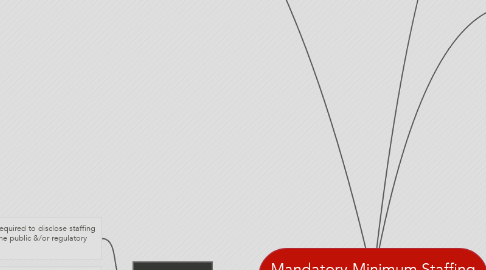
1. Initiatives in other states
1.1. Ohio: committee in hospital
1.1.1. minimum staffing plan
1.1.2. consistent with current standards
1.1.3. annual evaluation
1.1.3.1. patient outcomes
1.1.3.2. clinical management
1.1.3.3. costs
1.2. Connecticut: Direct Care RN Committee
1.2.1. Determine minimum professional skill mix for each unit
1.2.2. determine policy for use of temp nurse services
1.2.3. direct care nurses do not include administrative duties
1.2.4. establish a review process
1.2.5. involve input from other team members
1.3. Texas: staffing policies
1.3.1. staffing committee
1.3.2. whistleblower protection
1.3.3. prohibition on mandatory overtime
1.4. Nevada: direct care nurse staffing committee
1.4.1. develop flexible staffing plan
2. Alternatives
2.1. Facilities required to disclose staffing levels to the public &/or regulatory body
2.2. Nurse-driven staffing committees
2.3. Specific nurse to patient ratios mandated by legislation or regulation
3. Staffing ratios and patient outcomes
3.1. More RNs=better patient outcomes
3.1.1. fewer cases of sepsis
3.1.2. fewer failure to rescue
3.1.3. lower hospital-related mortality
3.1.4. shorter length of stay
3.2. High workload=problems
3.2.1. infections
3.2.2. failure to rescue
3.2.3. shock
3.2.4. cardiac arrest
3.3. Higher patient-to-nurse ratio
3.3.1. direct effect on patient outcome
4. Are mandatory minimum staffing ratios needed?
4.1. Assure adequate staffing
4.1.1. Determined by others
4.1.1.1. federal vs. state
4.1.1.2. urban vs. rural
4.1.2. Determined by hospital
4.1.2.1. safety vs. budget
4.1.2.2. know what they need better than outside source
4.1.3. Determined by numbers or acuity
5. California Prototype
5.1. Passing Legislation
5.1.1. nursing unions
5.1.2. bad press
5.1.3. increase in unlicensed assistive personnel
5.1.4. increased patient loads
5.2. Determining the Ratios
5.2.1. Patient Classification System=necessary
5.2.2. Staffing ratios=minimum
5.3. Implementation
5.3.1. who is a "licensed nurse?"
5.3.1.1. RN=yes
5.3.1.2. LPN/LVN=no
5.3.2. Other staff
5.3.2.1. Keep as #s are based on current patterns of staffing
5.3.3. Comply immediately
5.3.3.1. threats to close if inadequately staffed
5.3.3.2. delay elective surgeries
5.3.3.3. gain public support
5.3.4. Waivers for some rural hospitals
5.4. "At all times"
5.4.1. Includes breaks and lunches
5.4.1.1. Rotating "float" staff
5.5. Compliance monitoring
5.5.1. Survey/complaint visits
5.5.1.1. Investigation
5.5.1.1.1. Deficiency
5.5.2. No penalty or fine for staffing itself
5.5.2.1. Fine for injury or death
5.5.2.2. Decrease patients or close if threat
5.6. Results
5.6.1. Cost
5.6.1.1. inconclusive
5.6.2. Quality
5.6.2.1. inconclusive
5.6.3. Patient outcome
5.6.3.1. inconclusive
